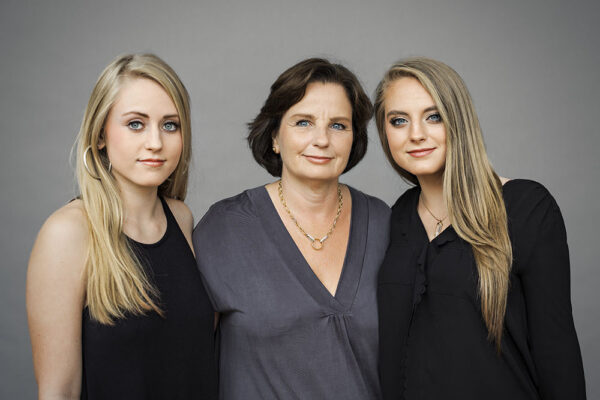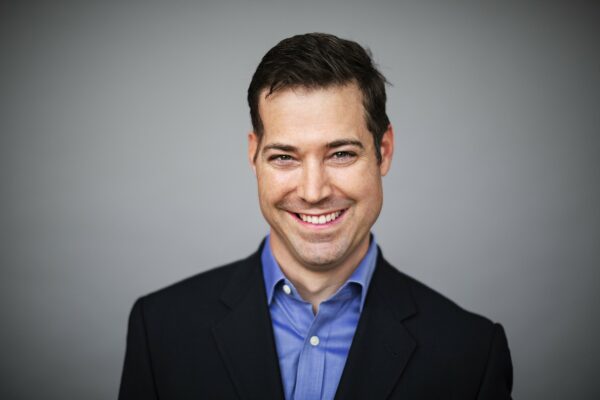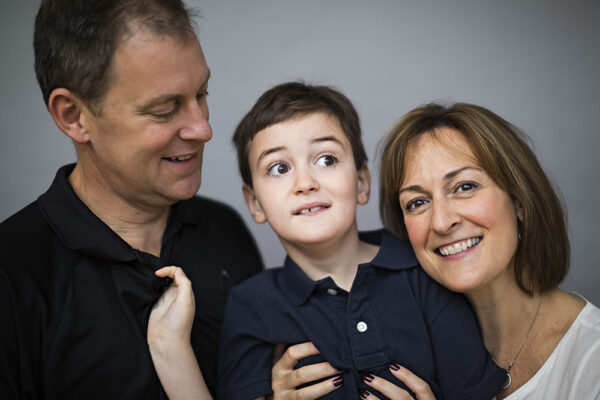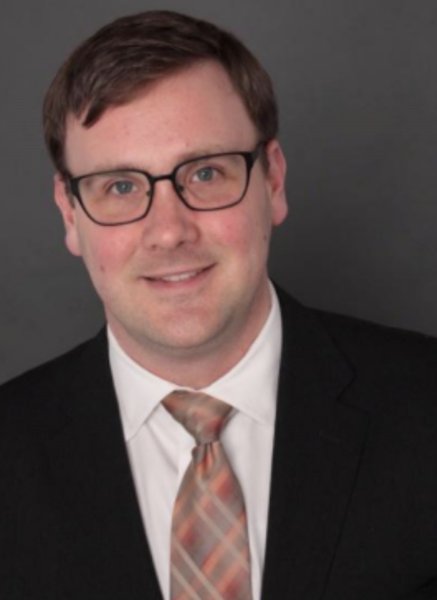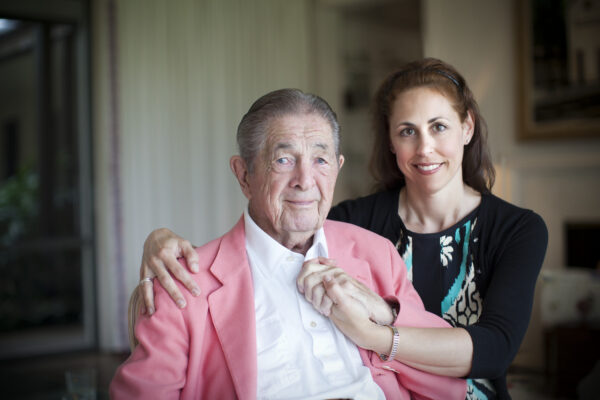
I came home from a Jesuit weekend retreat in late October, 1958, and Marg said, “Notice that occasionally, Lisa will have little spasms of her arms as if she were waving to someone.” Sure enough, I noticed these involuntary movements and we were all concerned. We soon had her to our pediatrician, a wonderful man named Dr. Sauer. He identified the problem as infantile spasms,” a mild form of epilepsy. He told us the prognosis was not severe, not uncommon and that with medication and over time, the condition would end.
But, as time passed, Lisa’s condition worsened. We sought every avenue of help and advice from neurologists. Wanted to take her anywhere, but all roads led to Dr. Frederic Gibbs in Chicago at the University of Illinois Research Hospital.
Once we met Fred and his wife Erna, we became devoted friends for the rest of their lives. Fred was Harvard trained and Erna was an M.D. in Germany. When they married, they moved to Chicago, but our country would not honor her German credentials, so she simply became a co-scientist with Fred and they worked shoulder to shoulder for their entire lives on the study of epilepsy. Fred was known as the “father of electroencephalography.” He worked for years with the Grass Instrument Company in the development of that instrument.
Well, we got Lisa to Fred and she was, of course, tested. The results were dismal. He could show us on the electroencephalograph the high spike activity. Every seizure caused brain damage. The diagnosis was hypsarrhythmia. Fred and Erna themselves had identified it in the early ’50s, and it was in the medical literature in 1953.
We were devastated. The prognosis was terrible. We asked, “What can we do?” Fred said, “Marg and Bill, there is nothing we can do” – but he hesitated and said, “There is a young doctor we met in Belgium this summer who has started to give hypsarythmic children shots of ACTH with some success.” Wow! There was someone who.believed. His name was Dr. Lucien Sorel. I’m sure he was the first doctor to try anything for the disease. ACTH was an early steroid made from a pig’s adrenaline gland. It was manufactured by Armour and Company in Chicago.
It took about a week to arrange a telephone conference with interpreters for Fred and Dr. Sorel. Dr. Sorel’s work was showing improvement in some children to whom he gave a modest 5 to 10 units intramuscularly each day. We were excited and told Fred we wanted to bring Sorel over. Fred said he would arrange a scientific conference on the subject.
I think it took about a month to make all the arrangements. Fred had an associate in his research program named Dr. Fred Stamps, a wonderful man and subsequent great friend. They invited all the neurologists and pediatricians from around the country to the semninar on Hypsarythmia. It was a two-day gathering. He was a most attractive young man with impressive credentials.
Marg and I had little understanding of their discussions, but we do know the result. A program was begun almost immediately at the University of Illinois by Gibbs and Stamps on intramuscular injections of ACTH. It went on for many years. All the children they had previously diagnosed were contacted and placed in the program. For all the children they brought back, the results were dramatic. Gibbs et al immediately doubled the dosage that Sorel had started with and, over the years, went to 5 and 10 times the original amounts.
Lisa may have been the first patient in this program in the country. We had great hopes. The program results were beginning to reveal that about one-third of the children were greatly improved in their seizure activity in a matter of weeks. Some were totally cured, a middle third were improved and the final third showed little or no benefit. Lisa, as we learned soon, was not in the first third. We thought she showed some improvement, but even that was questionable. We shared the excitement of the doctors in the overall success of the program, but privately, were devastated by Lisa’s lack of progress. It was a tremendous ordeal for Marg. The logistics of getting Lisa to Evanston Hospital for shots by a neurologist (whom we did not like) were most difficult. Thank God we were blessed with the help we had over those dreadful years. Katie and Melvin were our team then! They were both devoted to Lisa. Katie particularly loved Lisa as if she were her own.
Lisa’s epilepsy caused tiny seizures that would last for a matter of seconds. Her eyes would roll back and she would simply slump straight down slowly on her haunches, not hurting herself in any way. It would shortly be over and immediately she would be back on her feet. We never knew how many of these took place daily. We guessed at: between 20 and 30. You never knew what might happen. There was no anticipation. The cumulative impact, of course, affected her mental development. She lost her ability to speak. Her motor skills were fair, but her responses to our affection were limited. Her eyes seemed dark and her smiles infrequent.
This went on pretty much between the ages of one and five. We tried everything and sought answers everywhere. We learned that in Philadelphia there was a neurological group practicing a new therapy, which I have since found out was called then, I believe, Domain and Delacotto Method. We went there and learned the program, which consisted of a group of friends – three or four at a time — working a child’s legs and arms manually through a series of exercises daily. I’ve forgotten for how long. It was meant to create, I believe, the seven neurological levels of human development we apparently all go through. In addition, there was much crawling, as a child does prior to walking. A lot of the crawling was supposed to be through a large, long tubular structure. I’ve forgotten why.
Loretto Hospital, a small institution on the west side of Chicago, was conducting a program in affiliation with the Philadelphia group. We took Lisa there; I don’t know for how long (Afte rall, I’m writing about 40 years after the fact). I also remember we had a large plastic tunnel in our upstairs hallway that we would all crawl through with Lisa. It didn’t seem to help her, and my guess is that Fred Gibbs did not give it much credibility. However, I do remember that I had an associate at Smith Barney’s Chicago office whose son had severe epilepsy. I told him about the program and he and his wife enrolled the boy and carried out a dedicated effort for a year with dramatic results. And I believe their son has lived a normal life ever since.
When Lisa was about four, the seizures increased in a serious way. Instead of having the resulting “slump,” she would become rigid and fall like a log in any direction, Now, she needed protection, especially for her head and face. Marg tried several kinds of helmets. A firm one, like a football helmet, was too uncomfortable, so she made one out of sponge that really helped. Lisa now spent much of her time in her bedroom, where furniture was all padded and the risk was low. We put an aperture in her door, so we could see her activity. She could play with dolls and toys to some extent and seemed happy alone. As I recall, Lisa seldom cried.
Obviously, things were not going well. The strain was beginning to be felt by Linda, Molly and Bill, let alone Nana Hoover and Marg’s brothers, my Dad and brother Jim, as well as our closest friends. The question was, “How long can we carry on without serious effects on the family?” This was not spoken of openly. It was implied – even by Drs. Gibbs and Stamps. (I used to pray that Lisa would be able to speak one word – that being “Jesus.”)
On one occasion, Lisa injured herself by a fall, and she stayed in Evanston Hospital for some period. All they could do was restrain her in bed until her head bruises healed.
By a storm of prayer — our own and countless others – life went on in this abnormal way, as it did for thousands of other families with handicapped children. We had incredible support, and the love that Linda, Molly and Bill had for Lisa was inspiring. The decision was ultimately up to us but, finally, the dear Lord spared us that decision.
I believe she was about five. We woke up one morning to find that she had fallen and suffered contusions in her head and face. She looked like she had been in a fight with a heavyweight. No blood, but hemorrhages in her scalp and face that turned her skin almost black. Fred Gibbs said, “Bill, don’t take her to Evanston. Bring her here to heal and we can look in on her. It’s a big ward, but well run.” This was Illinois Research Hospital in Chicago, adjacent to St. Luke’s. She was there about a month, her body absorbing the hemorrhage and healing.
During that period, Linda was a freshman at Marymount College near New York. I was going to New York with great frequency in those days, as a member of Smith Barney’s Executive Committee. I had arranged to meet Linda at the Plaza Hotel for dinner. I remember coming down the elevator, and as I got off, she raced across the room into my arms and collapsed. I got her up to my room and called Marg and Eliot Foltz, our doctor in Winnetka. He said to get her on a plane and to come directly to Evanston Hospital, which I did. Eliot met us, and she was admitted to the psychiatric floor with an obvious nervous breakdown. I believe she was in the hospital for about a month.
Linda lived with us for a year, attending local colleges. She returned to New York, where she attended another school, Finch, and was under psychiatric care for at least a year, with great success.
So, with Lisa and Linda both in hospitals – across town from each other. We were emotionally drained. Each night, I would leave the office and cab it to see Lisa. Marg would drive there from Winnetka, no easy endeavor. We might or might not have seen Fred Gibbs or Ema or Stamps, and then we would be off to see Linda, speak to the doctors and find out anything we could from staff about her day — or progress. We might stop for a quick dinner on the way to see Linda or on the way home. It was a tough time in our lives, to say the least.
When Lisa was healed and ready to come home, Gibbs and Stamps met with us. Essentially, the said they were at the end of their string” I believe members of our family would have to be placed in special care, for our sake and that of the entire family. As the issue was on the table, they submitted the idea that there was one more thing they wanted to try – something they had never done before. Namely, to give Lisa intravenous of ACTH, rather than intramuscular injections. They referred to unknown risks, because the steroid had never penetrated her system. They asked us to consider it.
As I recall, we went home and talked about all the aspects and alternatives for her future life. We decided it had to be tried. It seems we spent most of the next two days in the hospital, over a weekend. They started on Friday with 50 units of ACTH, a fairly large dosage, and continued on Saturday and Sunday. I don’t know exactly how we knew, but the glorious miracle took place: Her seizures ended!! It was so hard to believe. After four years. To my memory, her next seizure was perhaps 20 years later when her grandmother Nana Hoover died in Florida while Lisa was visiting us. She may have had one or two while at the Bancroft School, but I believe, always associated with a traumatic event, such as the loss of a dear school friend.
So her life truly began that day. She started to talk again, and no longer had that haunting look. Life for Marg, especially, but for all of us as well, took on some semblance of normalcy. We built a support system for Lisa, consisting of specialized teaching and specialized schooling. She even took piano lessons from a dear woman in Wilmette. Marg and I devoted a great deal of time to the building of the Brain Research Foundation, a dream of Fred Gibbs. (That is a long story in itself, which I hope to write about.) But, due to the effort of a lot of magnificent people, the Foundation has grown and flourished, in affiliation with the University of Chicago and the neuroscientists there.
At about 13 or 14, Lisa said to her mother, “Mother — Linda, Molly and Billy all went away to school. Why can’t I?” That was a glorious moment, and we began a search. I believe we visited special schools in Pennsylvania, Kentucky, California and Wisconsin. Nothing seemed right for her. Then one day, Marg saw a little ad in the last pages of a well-known magazine regarding the Bancroft School in Haddonfield, New Jersey, Marg sent off for brochures, We read them and went there for interviews. It is curious that even though this was about 32 years ago, we received little or no help from the doctors, neither neurologists nor pediatricians. There was little information available about special education.
So a new life began for Lisa about 30 years ago. (Established in 1883, Bancroft serves the handicapped from childhood to adulthood. The school and programs have grown immensely and now it is called Bancroft NeuroHealth.) Linda and I took her to Owl’s Head, Maine, to Bancroft’s summer camp program. We were introduced by staff to other campers and the facilities. Saying goodbye I could never describe. Linda and I shook with emotion and tears after our last wave. She was in the swimming pool with a lovely smile on her face. Thank God Marg was not along.
Another part of Lisa’s life – and certainly an important part of our own – was her scoliosis. I don’t know exactly when we noticed her curvature. Maybe when sh That road led to Dr. Blount in Milwaukee. He had developed the “Milwaukee Brace.” He was a wonderful man. He and his nurse fell in love with Lisa, and she with them. She was to wear the brace for a year, to be out of it only when she bathed or was in a pool. Every six months, we would bring her home from New Jersey, take her to Milwaukee to be evaluated and then Dr. Blount would say, “Lisa, darling, please give me just six months more.” What a trooper she was! Pure guts! On the way home, we would all cry and life would resume its regular course. This went on for years.
One weekend, on one of our frequent visits to New Jersey, we had gone into Philadelphia to a favorite hotel to have dinner at one of our special places, “The Humphrey Bogart Room.” We were having cocktails, Lisa, her glass of wine, and she said, “Daddy, I have an announcement to make. I am through with my brace – forever!” I was stunned. I believe Marg had already been told. But, in a few moments, I began to realize how momentous her decision was. It was hers! It was final! Naturally, we all cried — and discussed how we could have a burning ceremony. It had been nine years that she had worn that ugly mass of steel and leather. What more could anyone have asked of her?
Lisa is now 45. She has been at Bancroft for 30 years, where she has graduated to every new level of independent living offered her. She lives in a townhouse in Voorhees, New Jersey, with several of her friends in similar houses nearby. Staff supervision is limited. I think Lisa may see a staff member, perhaps, twice a week.
Over the years, she has worked at a flower shop and an apparel shop. For the past several years, she has worked with pre-school children at her church three or four hours a day, four times a week. She loves children and does an excellent job with them. She has two roommates – both men. Frank, in his early 50s, works daily in Philadelphia in the mailroom of an old-line investment firm. I believe he has been there about 25 years. Has no family. Nichos, her alleged boyfriend, has worked in a variety of jobs and is handicapped in speech and in writing. His parents are both lawyers and divorced. But he has good family support from them and his brothers.
They go to movies, bowling, a block away in Echelon Mall, where they often go to browse and share in the activity. Over the years, Lisa has participated in many Special Olympics – tennis, bicycling, running. She would try anything and has many ribbons to show for it. Because of fortunate financial circumstances, she frequently goes into Philly to theatre, ballet or symphony, as well as into New York for the same. She has traveled extensively, both with us and with Bancroft groups. She’s been to Europe several times, Hawaii, the Caribbean and all over the U.S. Gladys Simpson, my secretary and for 43 years a near member of our family, and Lisa were devoted friends and they would travel a lot together. Gladys always dreamed up interesting places to go, and Lisa became an excellent traveler.
About two years ago, Lisa was asked to serve on the Board of Trustees of Bancroft NeuroHealth. She is one of two “client” members. It was a great honor and she is a proud, enthusiastic trustee, who takes the meetings seriously and I am sure, in her disarming way, she makes a contribution.
So we feel her life is full. Because of her own handicaps, and living for 30 years with hundreds of young people and adults who have handicaps greater than her own, she has become a remarkably sensitive, understanding, empathetic human being. More so than anyone I have ever known, outside of her mother. She is realistic. Adaptable to any circumstances. She has a beautiful faith and openly expresses it. Her best friends are totally dear to her – no matter how they look, or walk or talk. Those wonderful people become oblivious to the handicaps of others and think only of others’ needs.
Lisa’s love for her sisters, brother, nieces, nephews and others is a joy to behold — as is their love for her. I guess I could go on indefinitely, as you can imagine. But just let me express our pride in her. No one in our family has accomplished as much, She started strong – acquired a dreadful disease. She lapsed into almost nothing. We almost lost her. A miracle took place. She began to rebuild – Overcoming great odds — and over the decades has become one of the most wonderful human beings we know.
